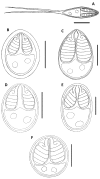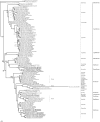Molecular phylogeny of the Myxobolus and Henneguya genera with several new South American species
- PMID: 24040037
- PMCID: PMC3764033
- DOI: 10.1371/journal.pone.0073713
Molecular phylogeny of the Myxobolus and Henneguya genera with several new South American species
Abstract
The present study consists of a detailed phylogenetic analysis of myxosporeans of the Myxobolus and Henneguya genera, including sequences from 12 Myxobolus/Henneguya species, parasites of South American pimelodids, bryconids and characids. Maximum likelihood and maximum parsimony analyses, based on 18 S rDNA gene sequences, showed that the strongest evolutionary signal is the phylogenetic affinity of the fish hosts, with clustering mainly occurring according to the order and/or family of the host. Of the 12 South American species studied here, six are newly described infecting fish from the Brazilian Pantanal wetland. Henneguya maculosus n. sp. and Myxobolus flavus n. sp. were found infecting both Pseudoplatystoma corruscans and Pseudoplatystoma reticulatum; Myxobolus aureus n. sp. and Myxobolus pantanalis n. sp. were observed parasitizing Salminus brasiliensis and Myxobolus umidus n. sp. and Myxobolus piraputangae n. sp. were detected infecting Brycon hilarii.
Conflict of interest statement
Figures



Similar articles
-
Molecular phylogeny and ultrastructure of Myxobolus cf. cuneus, a parasite of patinga hybrid and Henneguya pseudoplatystoma, a parasite of pintado hybrid.Acta Parasitol. 2015 Sep;60(3):442-50. doi: 10.1515/ap-2015-0061. Acta Parasitol. 2015. PMID: 26204181
-
Phylogenetic and host-parasite relationship analysis of Henneguya multiplasmodialis n. sp. infecting Pseudoplatystoma spp. in Brazilian Pantanal wetland.Vet Parasitol. 2012 Apr 30;185(2-4):110-20. doi: 10.1016/j.vetpar.2011.10.008. Epub 2011 Oct 20. Vet Parasitol. 2012. PMID: 22051071
-
18S and 28S rDNA identity and phylogeny of two novel myxosporeans infecting gills of cyprinid carps inhabiting a cold water wetland in northern India.Microb Pathog. 2018 Jul;120:97-108. doi: 10.1016/j.micpath.2018.04.042. Epub 2018 Apr 25. Microb Pathog. 2018. PMID: 29704669
-
Molecular Genetic Studies on Myxobolus cylindricus and Henneguya mystasi (Myxosporea: Myxobolidae) Infecting Two Indian Fish Species, Channa gachua and Mystus vittatus, Respectively.Acta Parasitol. 2019 Mar;64(1):129-137. doi: 10.2478/s11686-018-00014-8. Epub 2019 Jan 14. Acta Parasitol. 2019. PMID: 30637559
-
Morphology and small subunit ribosomal DNA sequence of Henneguya suprabranchiae (Myxozoa), a parasite of the catfish Clarias gariepinus (Clariidae) from the River Nile, Egypt.Parasitol Res. 2012 Oct;111(4):1423-35. doi: 10.1007/s00436-012-2976-9. Epub 2012 Jun 15. Parasitol Res. 2012. PMID: 22699967
Cited by
-
Diversity of myxozoans parasitizing the catfish Rhamdia quelen (Siluriformes: Heptapteridae), in southeastern Brazil, based on morphological and molecular evidence.Sci Rep. 2022 Oct 20;12(1):17596. doi: 10.1038/s41598-022-22418-3. Sci Rep. 2022. PMID: 36266420 Free PMC article.
-
Morphological and molecular studies on two myxosporean infections of cyprinid fishes: Thelohanellus pyriformis from tench and Thelohanellus cf. fuhrmanni from nase.Int J Parasitol Parasites Wildl. 2022 Apr 14;18:119-127. doi: 10.1016/j.ijppaw.2022.04.003. eCollection 2022 Aug. Int J Parasitol Parasites Wildl. 2022. PMID: 35572036 Free PMC article.
-
The morphological and molecular characterization of Henneguya rotunda n. sp., a parasite of the gill arch and fins of Salminus brasiliensis from the Mogi Guaçu River, Brazil.Parasitol Res. 2014 May;113(5):1703-11. doi: 10.1007/s00436-014-3815-y. Epub 2014 Feb 18. Parasitol Res. 2014. PMID: 24535737
-
Ortholinea auratae n. sp. (Myxozoa, Ortholineidae) infecting the urinary bladder of the gilthead seabream Sparus aurata (Teleostei, Sparidae), in a Portuguese fish farm.Parasitol Res. 2014 Sep;113(9):3427-37. doi: 10.1007/s00436-014-4008-4. Epub 2014 Jul 3. Parasitol Res. 2014. PMID: 24985497
-
Host-Parasite Interaction and Phylogenetic of a New Cnidarian Myxosporean (Endocnidozoa: Myxobolidae) Infecting a Valuative Commercialized Ornamental Fish from Pantanal Wetland Biome, Brazil.Pathogens. 2022 Sep 29;11(10):1119. doi: 10.3390/pathogens11101119. Pathogens. 2022. PMID: 36297176 Free PMC article.
References
-
- Feist SW, Longshaw M (2006) Phylum Myxozoa. In: Woo PTK, editor. Fish diseases and disorders: Protozoan and Metazoan infections. 2a ed. UK: CAB International. 230–296.
-
- Lom J, Dyková I (2006) Myxozoan genera: definition and notes on taxonomy, life-cycle terminology and pathogenic species. Folia Parasitol 53: 1–36. - PubMed
-
- Yokoyama H, Masuda K (2001) Kudoa sp (Myxozoa) causing a post-mortem myoliquefaction of North-Pacific giant octopus Paroctopus dofleini (Cephalopoda : Octopodidae). B Eur Assoc Fish Pat 21: 266–268.
-
- Hartigan A, Fiala I, Dyková I, Rose K, Phalen DN, et al. (2012) New species of Myxosporea from frogs and resurrection of the genus Cystodiscus Lutz, 1889 for species with myxospores in gallbladders of amphibians. Parasitology 139: 478–496. - PubMed
Publication types
MeSH terms
Substances
Associated data
- Actions
- Actions
- Actions
- Actions
- Actions
- Actions
- Actions
- Actions
- Actions
- Actions
- Actions
- Actions
- Actions
- Actions
- Actions
LinkOut - more resources
Full Text Sources
Other Literature Sources
Molecular Biology Databases

